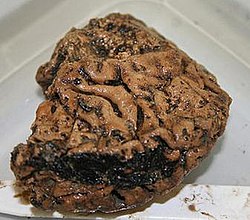 Global Information
Global InformationHeslington Brain information
| Heslington Brain | |
|---|---|
 Mass "A" of the Heslington Brain | |
| Material | Human brain |
| Size | (Mass "A") 70 millimetres (2.8 in) × 60 millimetres (2.4 in) × 30 millimetres (1.2 in) |
| Created | 673–482 BC |
| Discovered | By York Archaeological Trust in August 2008 |
| Place | Heslington, Yorkshire |
The Heslington Brain is a 2,600-year-old human brain found inside a skull buried in a pit in Heslington, Yorkshire, in England, by York Archaeological Trust in 2008. It is the oldest preserved brain ever found in Eurasia, and is believed to be the best-preserved ancient brain in the world.[1] The skull was discovered during an archaeological dig commissioned by the University of York on the site of its new campus on the outskirts of the city of York. The area was found to have been the site of well-developed permanent habitation between 2,000–3,000 years before the present day.
A number of possibly ritualistic objects were found to have been deposited in several pits, including the skull, which had belonged to a man probably in his 30s. He had been hanged before being decapitated with a knife and his skull appears to have been buried immediately. The rest of the body was missing. Although it is not known why he was killed, it is possible that it may have been a human sacrifice or ritual murder.
The brain was found while the skull was being cleaned. It had survived despite the rest of the tissue on the skull having disappeared long ago. After being extracted at York Hospital, the brain was subjected to a range of medical and forensic examinations by York Archaeological Trust which found that it was remarkably intact, though it had shrunk to only about 20% of its original size. It showed few signs of decay, though most of its original material had been replaced by an as yet[when?] unidentified organic compound, due to chemical changes during burial.
According to the archaeologists and scientists who have examined it, the brain has a "resilient, tofu-like texture". It is not clear why the Heslington brain survived, although the presence of a wet, anoxic environment underground seems to have been an essential factor, and research is still ongoing to shed light on how the local soil conditions may have contributed to its preservation.
- ^ Cite error: The named reference
Medical Dailywas invoked but never defined (see the help page).